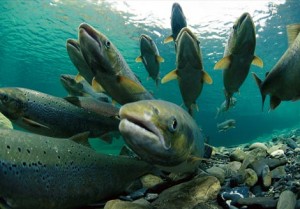19
Jul
Common Pesticide Exposure Alters Behavior of Fish and Amphibians
(Beyond Pesticides, July 19, 2016) Exposure to common pesticides at levels often found in the environment can have subtle but significant impacts on the behavioral health of fish, amphibians and other aquatic invertebrates. According to researchers at Northern Arizona University, who analyzed data from nearly 40 experiments to reach their conclusion, fish and amphibians swam 35% slower and were 72% less active after pesticide exposure.
| Chemical Class | Type | Example Pesticides |
| Carbamates | Insecticide | Carbaryl, Aldicarb |
| Organochlorine | Insecticide | DDT, Endosulfan, Chlordane |
| Organophosphates | Insecticide | Diazinon, Chlorpyrifos |
| Organotins | Biocide | Tributyltin |
| Phosphonoglycines | Herbicide | Glyphosate, Glufosinate |
| Pyrethroids | Insecticide | Permethrin, Bifenthrin, Esfenvalerate |
| Triazines | Herbicide | Atrazine, Simazine |
The study, published in Science of the Total Environment, found that the overall effect on aquatic wildlife varied based on the chemical class the animals encountered. While pyrethroids, carbamates, and organophosphates resulted in a significant decrease in swim speed, triazines and phosphonoglycines showed no overall effect. Pyrethroids, carbamates, organophosphates, organochlorines, and organotins decreased activity, while phosphonoglycines had no overall effect, and triazines actually increased activity. “I didn’t think that we would see [an effect] across such a wide range of pesticides so consistently, but we did,” said study co-author, Catherine Propper, PhD to KNAU, “and that leads to some concerns about environmental exposure for organisms.”
Changes in swim speed and activity level of fish and amphibians can have profound implications for their overall fitness in the environment. Authors of the analysis cite several studies linking specific sublethal pesticide exposures to reduced health outcomes. For example, one study finds reduced activity levels in flathead minnows after exposure to a pyrethroid can result in higher predation and slower growth rates. Salmon exposed to carbamates and organophosphates result in reduced growth, feeding, and size at the time of their migration. Other studies find that pesticide-induced decreases in activity can result in reduced predation on amphibians, but at the cost of reduced growth and delayed development.
The effects of pesticide exposure can alter  species interactions, and potentially create trophic cascades, situations where the interaction between predators and prey in the food web becomes imbalanced. For example, a predacious fish may, under normal circumstances, exert a population control on smaller fish that feed on insects that eat algae. Decreased activity and reduced predation among predacious fish can result in an explosion of smaller fish, which can then result in an overconsumption of algae-eating insects, ultimately leading to an increase in algae in an aquatic area. These difficult to perceive interactions underscore the call from the authors of the study for future research to better understand how pesticide-induced changes in behavior can alter the fitness, populations, and make-up of aquatic communities and ecosystems.
species interactions, and potentially create trophic cascades, situations where the interaction between predators and prey in the food web becomes imbalanced. For example, a predacious fish may, under normal circumstances, exert a population control on smaller fish that feed on insects that eat algae. Decreased activity and reduced predation among predacious fish can result in an explosion of smaller fish, which can then result in an overconsumption of algae-eating insects, ultimately leading to an increase in algae in an aquatic area. These difficult to perceive interactions underscore the call from the authors of the study for future research to better understand how pesticide-induced changes in behavior can alter the fitness, populations, and make-up of aquatic communities and ecosystems.
The varying interactions as a result of sublethal exposure from a range of common pesticide classes highlights the need for the U.S. Environmental Protection Agency (EPA) to re-evaluate its methodology for analyzing the impacts of these chemicals. As it stands, EPA’s review of pesticide ingredients fails to account or deems negligible difficult to perceive impacts on wildlife, such as changes in behavior or endocrine disruption. Instead, the agency relies on an outdated toxicological approach focused on acute effects, and the 16th-century maxim that “the dose makes the poison.” Independent science continues to tell us otherwise; the effects of these chemicals in the real world are much more complex than the scope of our regulatory system under EPA.
For more information on the impacts of pesticides on wildlife, and what you can do to reverse biodiversity declines, see Beyond Pesticides new Wildlife program page. There you can find out not only the ecological impacts of pesticides, but the add-on effect these situations create for your wallet, and the litigation underway to save threatened and endangered species. Additional information about pesticides and aquatic environments can be found on the Threatened Waters program page.
All unattributed positions and opinions in this piece are those of Beyond Pesticides.
Source: KNAU, Science of the Total Environment










